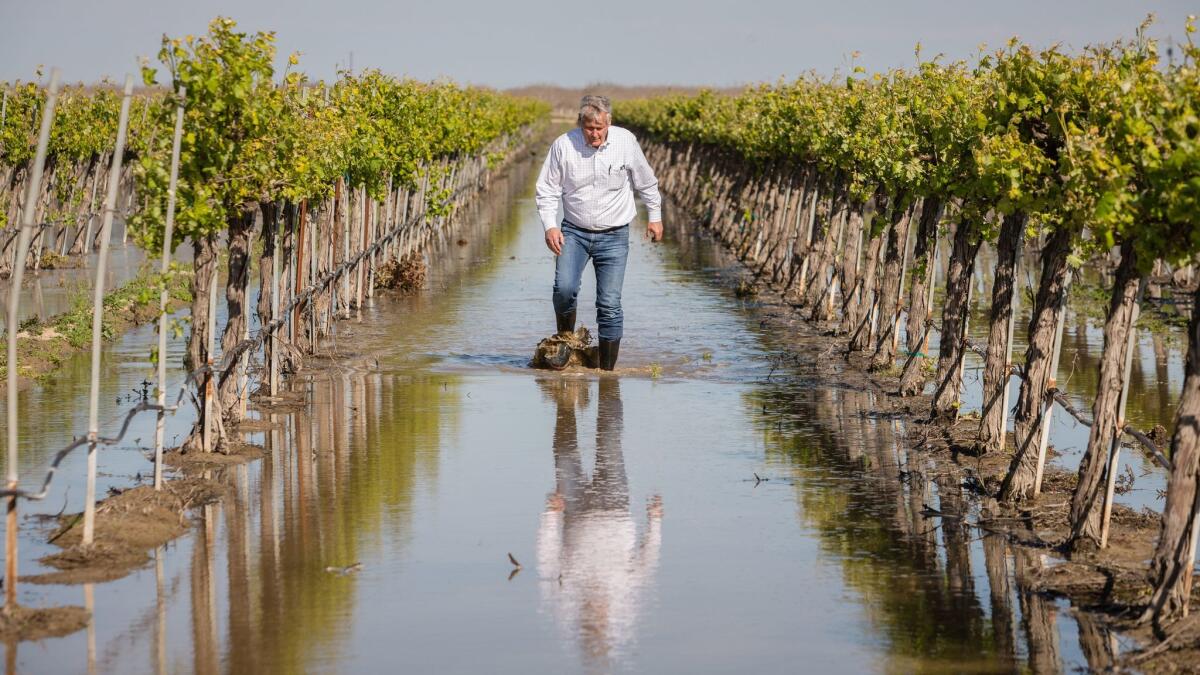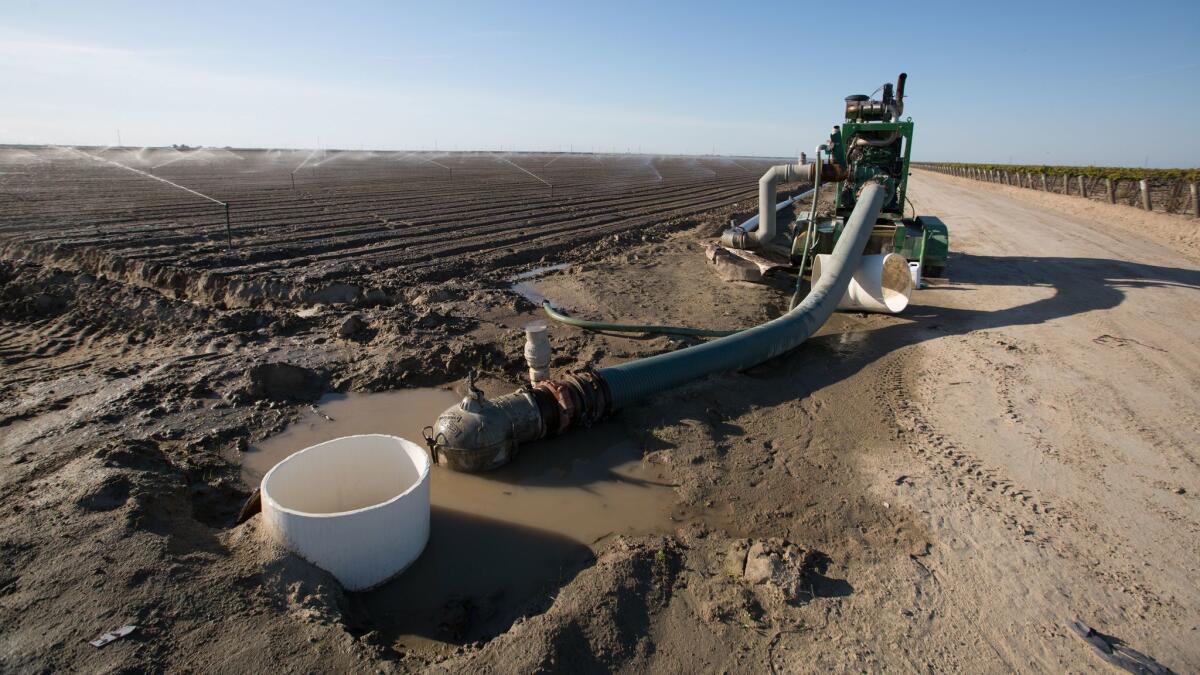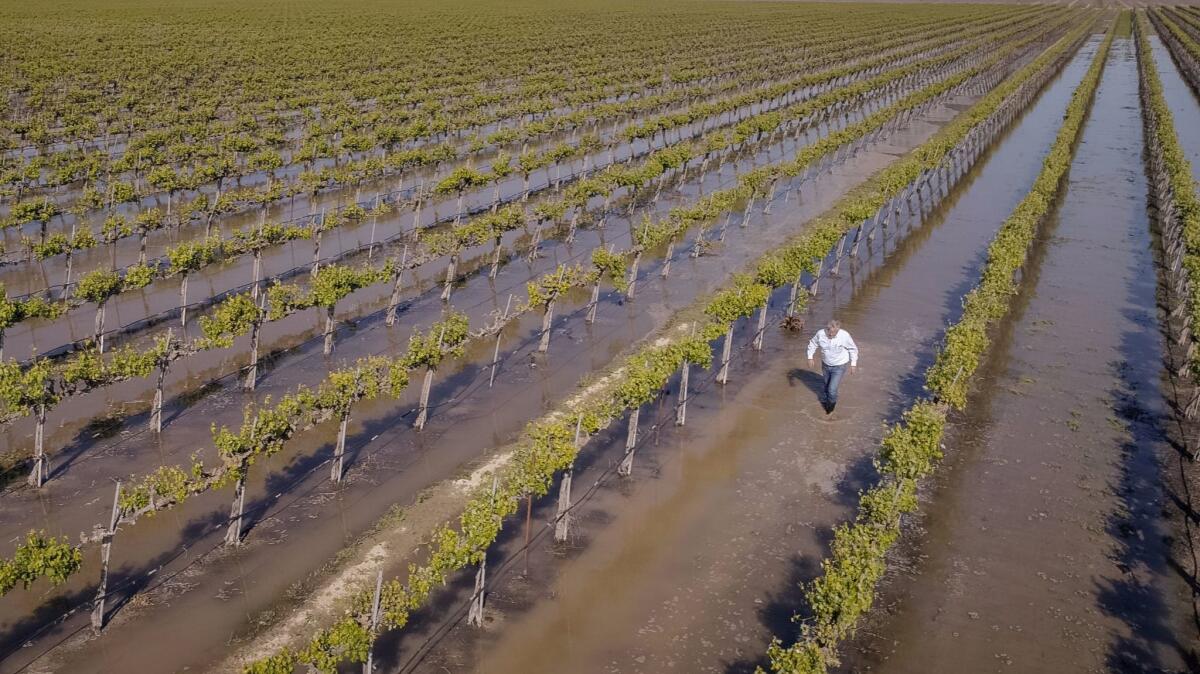One key way soggy California could save water for the next dry spell

Valley grower Don Cameron uses high flows off the Kings River to flood vineyards, nut groves and alfalfa fields to recharge the local groundwater basin.
- Share via
Reporting from Helm, Calif. — The water spread into every corner of the fields, beckoning wading ibises and egrets as it bathed long rows of sprouting grapevines.
Several inches had covered the vineyard ground for a couple of months. But rather than draining it, Don Cameron was pouring more on.
“This is not about irrigation,” the sprawling farm’s manager kept telling his quizzical workers. “It’s about recharge. … I want all the water you can get into the grape fields now.”
After a drought-busting winter, reservoirs up and down California are dumping water to make room for spring snowmelt.
We have a great reservoir under our feet. Why not use it?
— Don Cameron, Terranova Ranch general manager
There is so much water in the state’s vast plumbing system that for weeks, the big government water projects have reduced exports from the Sacramento-San Joaquin Delta. San Luis Reservoir, where the projects park water on its way south, is full.
Yet there is more room than ever in one of the state’s most capacious storage spaces: the San Joaquin Valley aquifer.
Parts of it have been overpumped for a century. Groundwater levels fell even farther during the past five years of drought as growers in California’s heartland drilled new and deeper wells to make up for huge cuts in irrigation deliveries.
“We have a great reservoir under our feet. Why not use it?,” Cameron asked.
The water spilling into the vineyard had been diverted from a brimming flood-control channel nearby. Now it seeped into the sandy loam at the rate of 3 to 4 inches a day, percolating into the San Joaquin Valley aquifer that, year in and year out, provides Terranova Ranch and its neighbors with most of their irrigation water.
“It goes down fast,” observed Cameron as he stood amid 150 acres of flooded Barbera vines that were topped with healthy new leaves and tiny clusters of grape buds.
Most of the time, the bed of the North Fork of the Kings River is bone-dry. Near Helm, where it is called the James Bypass, the channel fills only when upstream Pine Flat Reservoir makes flood releases.
This year, milk-chocolate flows are streaming down the bypass, swirling past islands of grass and half-submerged shrubs. The chatter of birds mixes with the sweet sound of rippling water as it makes its way to the San Joaquin River and ultimately out to sea.
But on the last day of March, 10,000 gallons a minute were passing through a 24-inch pipe into a canal Cameron built to carry the water to his Arbequina olive groves, baby pistachio trees, alfalfa and Barbera grapes that Gallo Winery buys. All told, Cameron is putting Kings River floodwater on about 700 acres this year, and he plans to continue the diversions as long as the flood flows hold up.
“We’re reconnecting the river to its flood plain,” he says.
The idea of using cropland to replenish groundwater basins is just beginning to take hold in California.
UC Davis researchers are conducting experiments to determine which crops will tolerate having their roots wet for weeks or months at a time. The Almond Board of California is funding work to identify almond acreage that has soil suitable for recharge.
Cameron has been at it much longer.
“We were pioneering this. We had a lot of skeptical people. To me it seemed natural,” he said.
“We lose 2, 2 ½ feet of water table a year [to overdraft]. It kind of adds up,” he added. “I realized a long time ago we need to take corrective action.”

White-haired and 64, Cameron is more willing to embrace unconventional practices than many growers -- probably, he says, because he doesn’t have a farm background.
“I’ve been called a communist,” he notes wryly.
Cameron grew up in Redding and Fresno, earned a biology degree from Fresno State and wanted to go into wildlife management.
When he didn’t get a state wildlife job, he wound up doing agricultural pest control work for a small company used by Terranova. In 1981, he went to work for the 5,500-acre farm operation, which is owned by a private family trust. Six years later he was named general manager and vice president.
During the record wet winter of 1982-83, Cameron drove by vineyards that had been flooded by the overflowing San Joaquin River. He kept watching as the months passed and the water receded. The vines bore healthy fruit and that September, pickers harvested the grapes.
“I thought ‘OK,’ and filed it away,” Cameron recalls.
He started experimenting with flood recharge on a small scale in the 1990s. In 2011, California’s last wet year, he flooded vineyards well into the growing season. They did just fine.
There is more room than ever in one of the state’s most capacious storage spaces: the San Joaquin Valley aquifer.

“We’ve proven in 2011 that it does work,” he said, adding that monitoring showed that 70% of the water applied to the fields made its way past the root zone into the aquifer.
He thinks one of the reasons it works is that the cold flood water holds oxygen, so the plant roots don’t suffocate. When the water temperature warms up in late spring, he stops.
But 700 acres is just the beginning. This summer Terranova expects to start construction on the first phase of a $7.5 million project to capture Kings River flood waters and use it for recharge on 16,000 acres of cropland.
A $5 million flood grant from the state is covering most of the cost, with the rest coming from Terranova. Backers have agreed to take a certain amount of flood water for as long as it is available to relieve downstream flooding.
“We’re designing this to make a difference in the area here,” Cameron said. “It will include all of the growers in our area.”
Neighboring farmers used to think Cameron was nuts. “But now,” he says “they’re believers,” — converted by a landmark 2014 state law that requires groundwater users to end overdraft over the course of the next two decades.
I’ve been called a communist.
— Don Cameron, Terranova ranch general manager
They will either have to increase aquifer recharge or cut back on pumping, which would likely force growers to take cropland out of production.
The law “is a big stick,” Cameron said. “They’re understanding how important it is to replenish our underground water supplies for the long term. Without doing this, we’re not going to be farming all our farmland. It’s pretty simple.”
But not every part of the valley can do what Terranova is doing.
“Part of the problem is getting the water to the right location,” Cameron said. “We desperately need more conveyance to move this kind of water when it is available.”
In some areas, the soil is too heavy for water to percolate into the aquifer. Some irrigation districts don’t have rights to flood water. Growers remain wary of harming their crops with weeks’ long baths.
And they fret that someone else will pump the water that they put in the ground.
Without doing this, we’re not going to be farming all our farmland. It’s pretty simple.
— Don Cameron, Terranova Ranch general manager

“I think it’s just not as easy as people would hope it could be,” said water researcher Philip Bachand, who is working on the Terranova project.
To overcome the concerns, growers need an incentive, said Daniel Mountjoy of Sustainable Conservation, a nonprofit group.
Why not pay growers to capture flood water and apply it their fields, he wonders.
The pricetag for new reservoirs sought by many in the farm sector is far greater than the cost of groundwater replenishment, Mountjoy said.
“So why don’t we use that storage money to pay a fraction of the cost and get farmers to fill that aquifer up to the extent possible?”
Cameron, for one, sees the obligation to replenish the groundwater reserves that keep fields green even through drought as more than a matter of money.
“Morally,” he says, “I thought it was the right thing to do.”
Twitter: @boxall
ALSO
L.A. legal fund to fight immigrant deportations draws criticism over who deserves representation
LAPD officers expected to face more scrutiny over shootings with new rules
UPDATES:
11;28 a..m.: This article was updated to include a link to an earlier story about groundwater replenishment.
More to Read
Sign up for Essential California
The most important California stories and recommendations in your inbox every morning.
You may occasionally receive promotional content from the Los Angeles Times.











